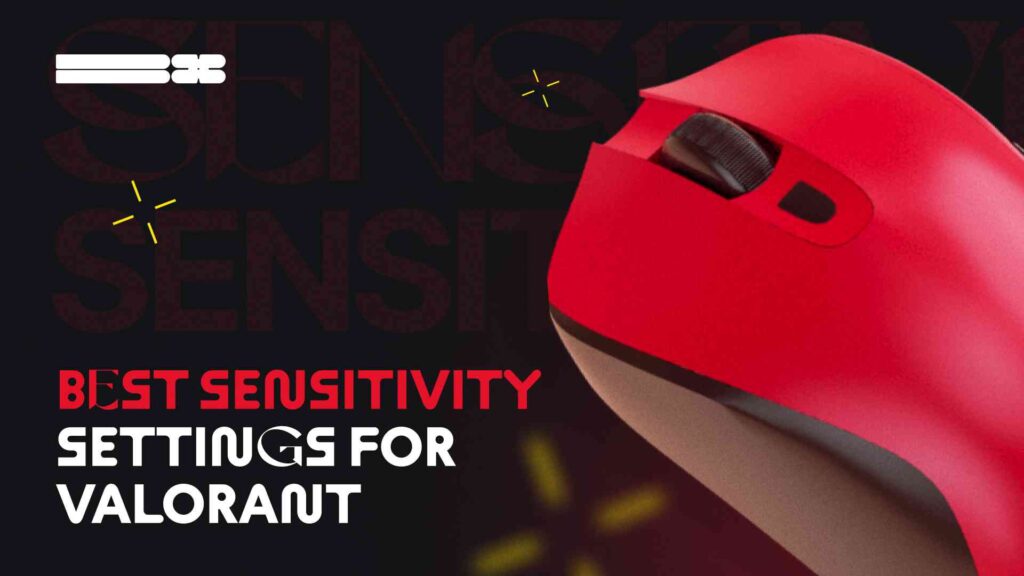Optimizing your sensitivity settings in any FPS is crucial for enhancing your accuracy and overall gameplay performance. We’ve made an article about sensitivity in Apex Legends. Now, this guide from the Blix team highlights common pitfalls to avoid, practical steps to practice new settings, and how to adjust other game configurations to complement sensitivity changes in Valorant.
This text is necessary because the proper sensitivity settings can significantly impact a player’s precision and reaction times, which are vital in competitive play. Our advice is based on expert recommendations and practices used by professional players, ensuring you receive reliable and practical guidance to improve your in-game performance.
Contents
- 1 Highlights
- 2 Introduction
- 3 Understanding Sensitivity in Valorant
- 4 Importance of DPI (Dots Per Inch)
- 5 Changing Sensitivity Settings in Valorant
- 6 Finding Your Perfect Sensitivity
- 7 Sensitivity for Valorant?
- 8 General Advice and Common Practices
- 9 Professional Player Settings
- 10 How to Find the Best Sensitivity for Valorant?
- 11 Tools and Methods to Test and Adjust Sensitivity
- 12 Sensitivity Settings Based on DPI
- 13 What is the Best Sensitivity for 800 DPI Valorant?
- 14 What is the Best Sensitivity for 1600 DPI Valorant?
- 15 Best Valorant Sensitivity for 1200 DPI
- 16 Sensitivity Preferences
- 17 What is the Best Aim Sensitivity for Valorant?
- 18 Best High Sensitivity for Valorant
- 19 Tips and Tricks
- 20 Typical Pitfalls and How to Avoid Them
- 21 How to Practice with New Sensitivity Settings
- 22 Adjusting Other Settings to Complement Sensitivity Changes
- 23 Conclusion
- 24 What is the best sensitivity to use in Valorant?
- 25 What sensitivity do pros use in Valorant?
- 26 How do I convert my sensitivity from other games to Valorant?
- 27 Is high sensitivity better for aiming in Valorant?
- 28 How does mouse DPI affect my gameplay in Valorant?
- 29 Can I use the same sensitivity settings across different games?
Highlights
- Explanation of the principles of sensitivity counting
- Advice on finding the best sensitivity settings for you
- Examples of top Valorant players’ sensitivity
- Tips and tricks for finer adjustments
Introduction
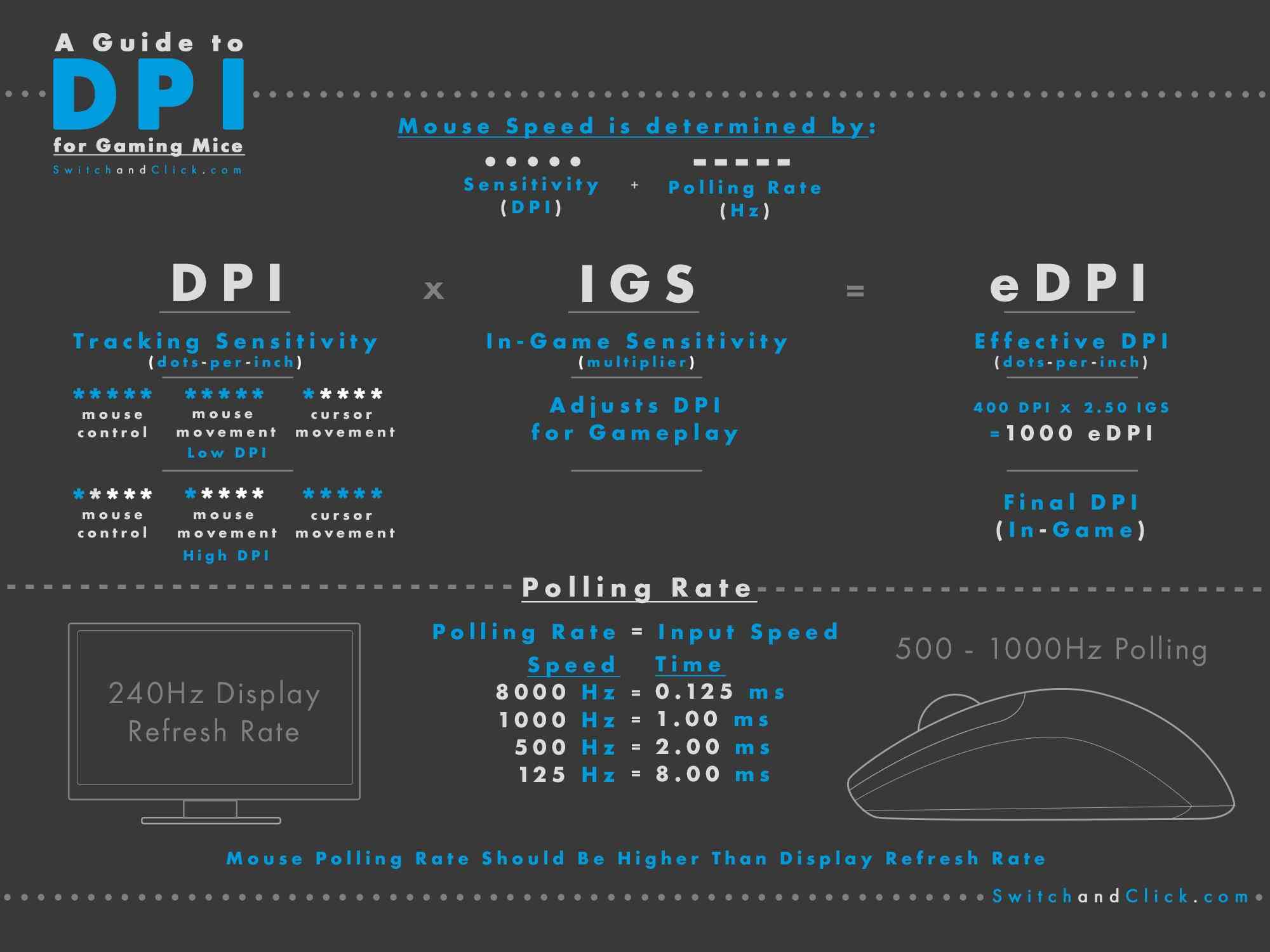
Mouse DPI
Finding the perfect sensitivity settings in Valorant can significantly improve your gameplay. Sensitivity settings determine how your in-game character reacts to your mouse movements. This guide covers everything you need to know about setting up the best sensitivity for different DPI settings, understanding sensitivity concepts, and tips for finding your ideal settings.
Understanding Sensitivity in Valorant
In Valorant, sensitivity settings adjust how much your in-game view moves when you move your mouse. Lower sensitivity values mean you need to move your mouse more to turn your character, which can enhance precision. Higher sensitivity values require less mouse movement, allowing quicker turns but potentially sacrificing accuracy.
Importance of DPI (Dots Per Inch)
DPI measures how many pixels your cursor moves per inch of mouse movement. Combining DPI with in-game sensitivity settings results in Effective Dots Per Inch (TPI), giving a more consistent sensitivity measure across different setups. For instance, if you have a DPI of 800 and an in-game sensitivity of 0.5, your eDPI is 400.
50% Less Input Lag! Low DPI vs. High DPI Analysis
Changing Sensitivity Settings in Valorant
To change sensitivity settings in Valorant:
- Go to the settings menu.
- Navigate to the ‘General’ tab.
- Adjust the ‘Sensitivity: Aim’ slider.
It’s crucial to tweak these settings gradually to find what feels right.
Finding Your Perfect Sensitivity
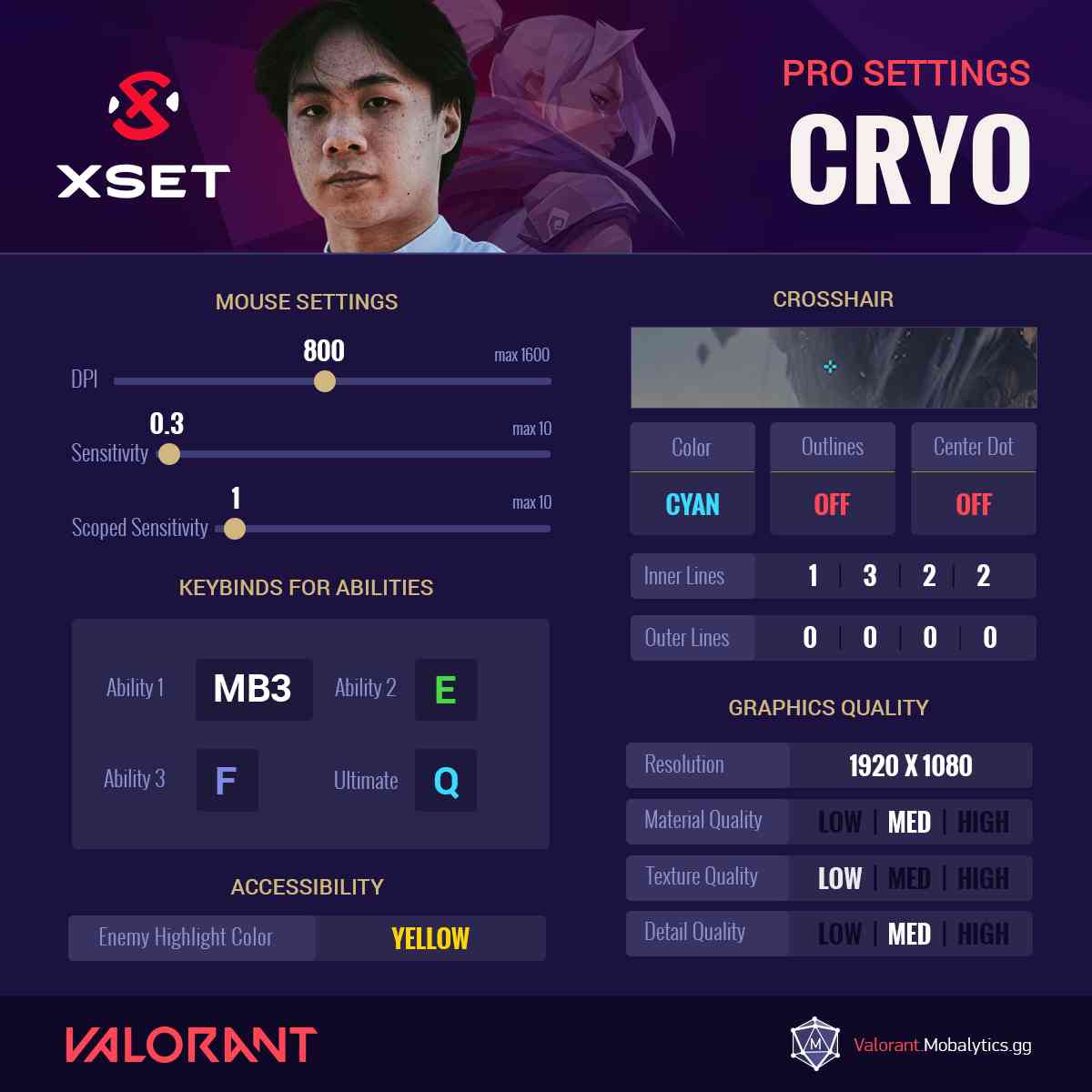
Cryo settings
Sensitivity for Valorant?
There’s no one-size-fits-all answer, but starting with a typical range can help. Many players find success with an eDPI between 280 and 350. For example, a DPI of 800 and an in-game sensitivity of 0.35 to 0.44 are typical settings many players and professionals use’.
General Advice and Common Practices
Starting Range: Most players begin with an eDPI of 280-350.
Adjusting for Comfort: Gradually tweak sensitivity to match your play style and comfort.
Consistency is Key: Stick with your chosen sensitivity to build muscle memory.
Professional Player Settings
Professional players often use lower sensitivities for better control and precision. For example, TenZ, a top Valorant player, uses a sensitivity of around 0.4 with a DPI of 800, resulting in an eDPI of 320’. Another example is ScreaM, known for his precision, who uses a similar range to maintain control.
How to Find the Best Sensitivity for Valorant?
Step-by-Step Guide to Experimenting with Different Settings
- Start with a Baseline: Use the expected eDPI range of 280-350 as a starting point.
- Hit the Practice Range: Spend time in the practice range to get a feel for your settings.
- Adjust Incrementally: Make minor adjustments to your sensitivity. Test each change thoroughly.
- Use Aim Training Tools: Tools like Aim Lab or Kovaak’s FPS Aim Trainer can help refine your sensitivity.
- Consider Your Play Style: Different roles might benefit from different sensitivities. For example, duelists may prefer higher sensitivity for quick movements, while snipers might opt for lower sensitivity for precision.
Tools and Methods to Test and Adjust Sensitivity
- Practice Range: Valorant’s in-game practice range is ideal for testing sensitivity.
- Aim Training Software: Programs like Aim Lab or Kovaak’s can simulate various scenarios to help fine-tune sensitivity.
- Real Matches: Apply your settings in real matches to see how they perform under different scenarios.
Sensitivity Settings Based on DPI
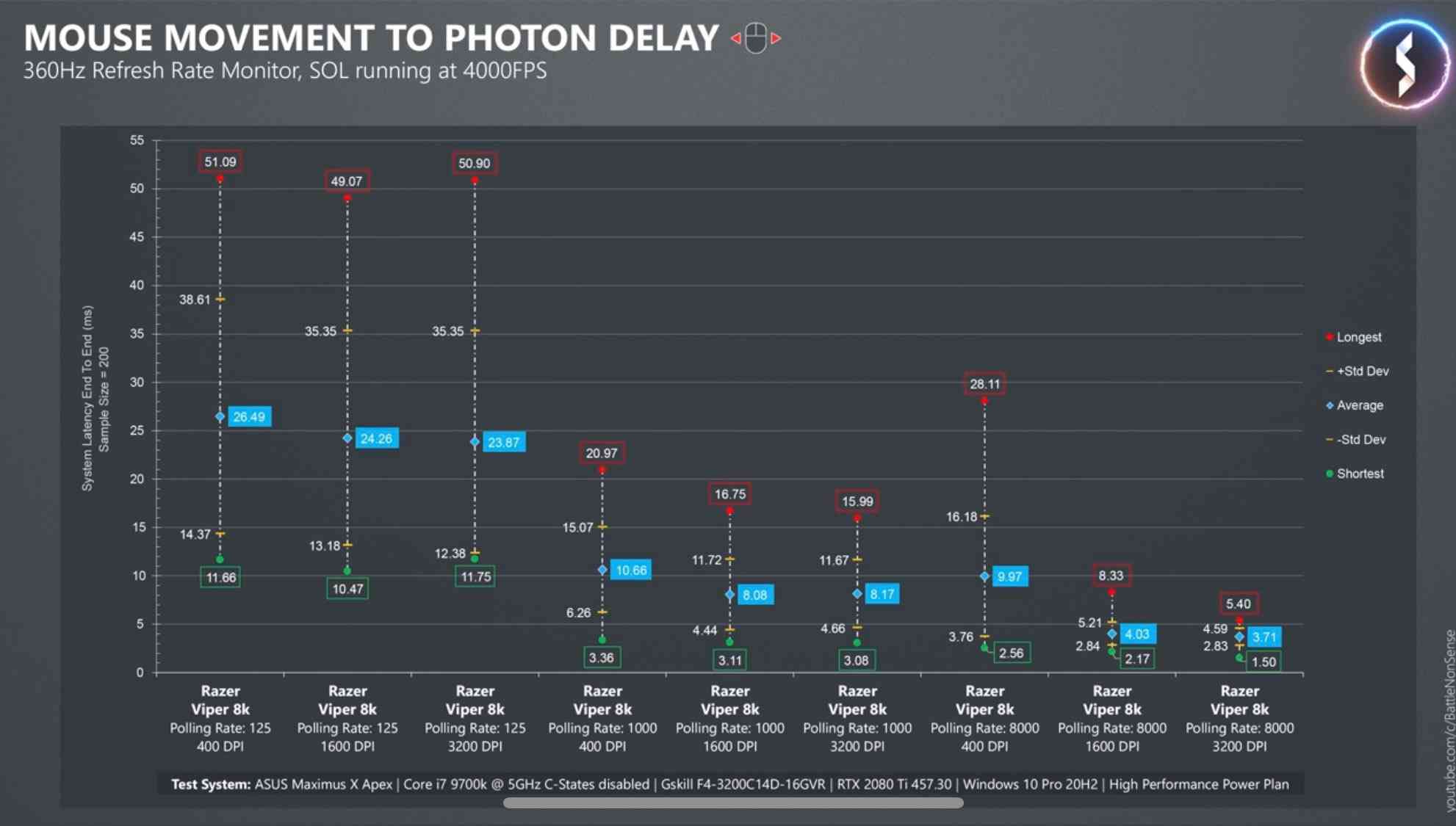
Mouse movement to photon delay
What is the Best Sensitivity for 800 DPI Valorant?
For 800 DPI, an in-game sensitivity of 0.35 to 0.44 is recommended. This range corresponds to an eDPI of 280 to 352, which balances quick reactions with accuracy’.
Recommended Sensitivity Range for 800 DPI
- Sensitivity Range: 0.35 to 0.44
- eDPI Range: 280 to 352
What is the Best Sensitivity for 1600 DPI Valorant?
For 1600 DPI, the in-game sensitivity should be lower, around 0.175 to 0.22, to maintain an eDPI within the effective range of 280 to 350. This helps manage the higher sensitivity the increased DPI provides’.
Recommended Sensitivity Range for 1600 DPI
- Sensitivity Range: 0.175 to 0.22
- eDPI Range: 280 to 352
Best Valorant Sensitivity for 1200 DPI
At 1200 DPI, a sensitivity range of 0.234 to 0.292 is optimal, aligning with the recommended eDPI of 280 to 350. This balance ensures you have precise control without overly fast movements’. Also, this is a good solution for 800VS1600 DPI argue.
Recommended Sensitivity Range for 1200 DPI
- Sensitivity Range: 0.234 to 0.292
- eDPI Range: 280 to 350
Sensitivity Preferences
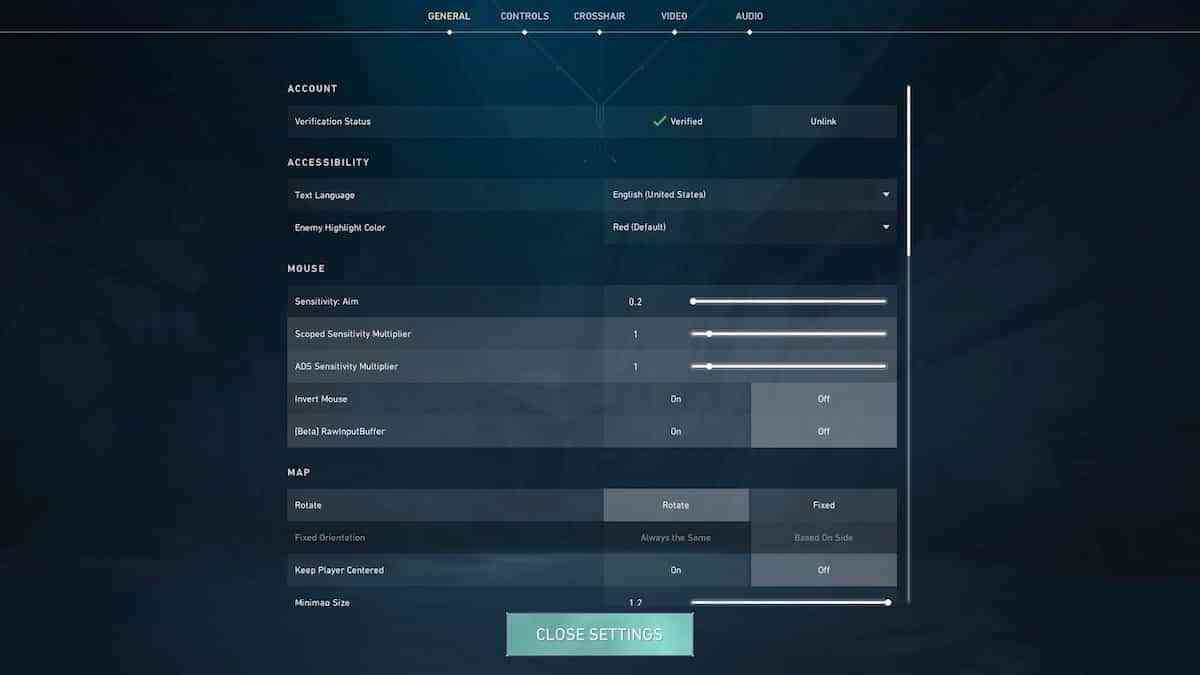
Sensitivity screen
What is the Best Aim Sensitivity for Valorant?
Finding the best aim sensitivity in Valorant can significantly impact your gameplay. The proper aim sensitivity allows for precise control and better targeting, leading to more accurate shots.
Discussion on Aiming and Its Impact on Gameplay
Aiming is crucial in Valorant, where precise shots can decide the outcome of a match. Aiming sensitivity affects your ability to aim at targets, track moving enemies, and control recoil. High sensitivity can help your ability to perform consistently.
Suggested Settings for Optimal Aiming
- eDPI Range: 280 to 350
- In-Game Sensitivity: Adjust according to your DPI to stay within the optimal eDPI range. For example, if using 800 DPI, aim for 0.35 to 0.44 sensitivity’.
Best High Sensitivity for Valorant
High-sensitivity settings can be advantageous in certain situations, especially for players who prefer fast-paced gameplay.
Benefits and Drawbacks of High-Sensitivity Settings
Benefits:
- Quick Movements: Allows rapid turns and fast reactions, which is beneficial in close-quarters combat.
- Less Desk Space Needed: Ideal for players with limited physical space for broad mouse movements.
Drawbacks:
- Reduced Precision: This can make it harder to aim precisely, especially at long distances.
- Inconsistent Control: This may lead to over-aiming or difficulty in controlling recoil.
- Situations Where High Sensitivity Might Be Preferable
- Duelists: Characters like Jett and Reyna, who engage in fast, close-up fights, might benefit from higher sensitivity for quicker target acquisition and reaction times.
- Close-Quarters Combat: Scenarios where rapid movement and quick 180-degree turns are necessary.
Tips and Tricks
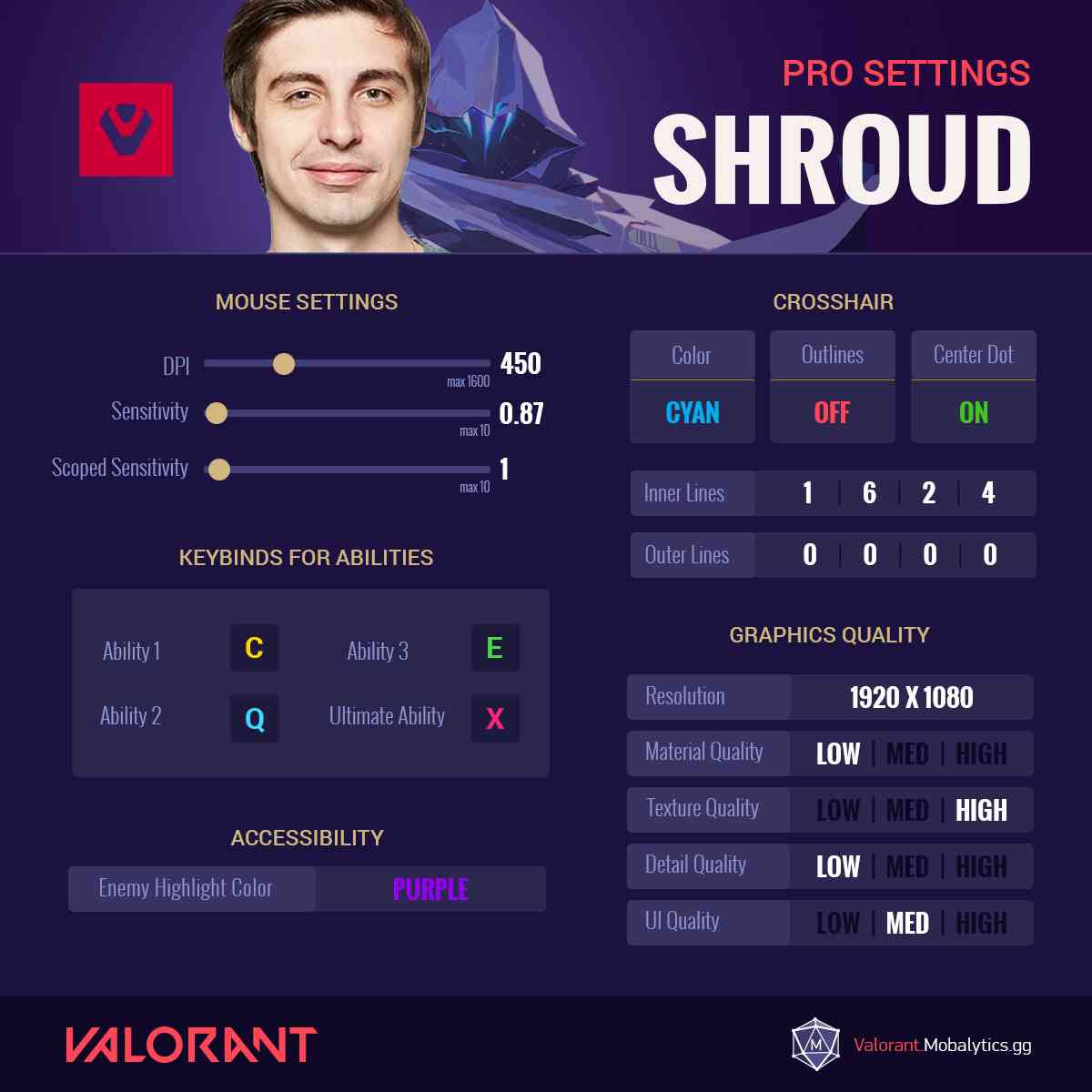
Shroud settings
Typical Pitfalls and How to Avoid Them
- Changing Sensitivity Too Often: Frequent changes can hinder muscle memory development. Stick with your chosen settings long enough to adapt and build consistency.
- Ignoring Desk Space: Ensure your sensitivity allows entire arm movement within your available desk space. Limited space can necessitate higher sensitivity, but find a balance that doesn’t sacrifice precision.
- Copying Others Blindly: Use pro settings as a guide, but tailor them to your comfort. Everyone’s setup and play style are unique, so adjust accordingly.
How to Practice with New Sensitivity Settings
- Warm-Up Routines: Regularly use the practice range or aim trainers.
- Match Play: Apply your settings in real matches to see how they perform under different scenarios. This practical application helps solidify muscle memory.
- Adjust Gradually: Apply tiny, gradual modifications to your sensitivity. Test each adjustment thoroughly before making further changes to avoid drastic shifts in performance.
Adjusting Other Settings to Complement Sensitivity Changes
- Crosshair Settings: A well-visible crosshair can improve accuracy. Customize the color, size, and shape to stand out against various backgrounds.
- Graphic Settings: Lowering settings can reduce lag and provide smoother gameplay. Higher frame rates can make aiming feel more responsive.
- Mouse Settings: Ensure your mouse polling rate is high (1000Hz) for more responsive input. This can enhance the overall feel of your mouse movements, making your sensitivity settings more effective.
Conclusion
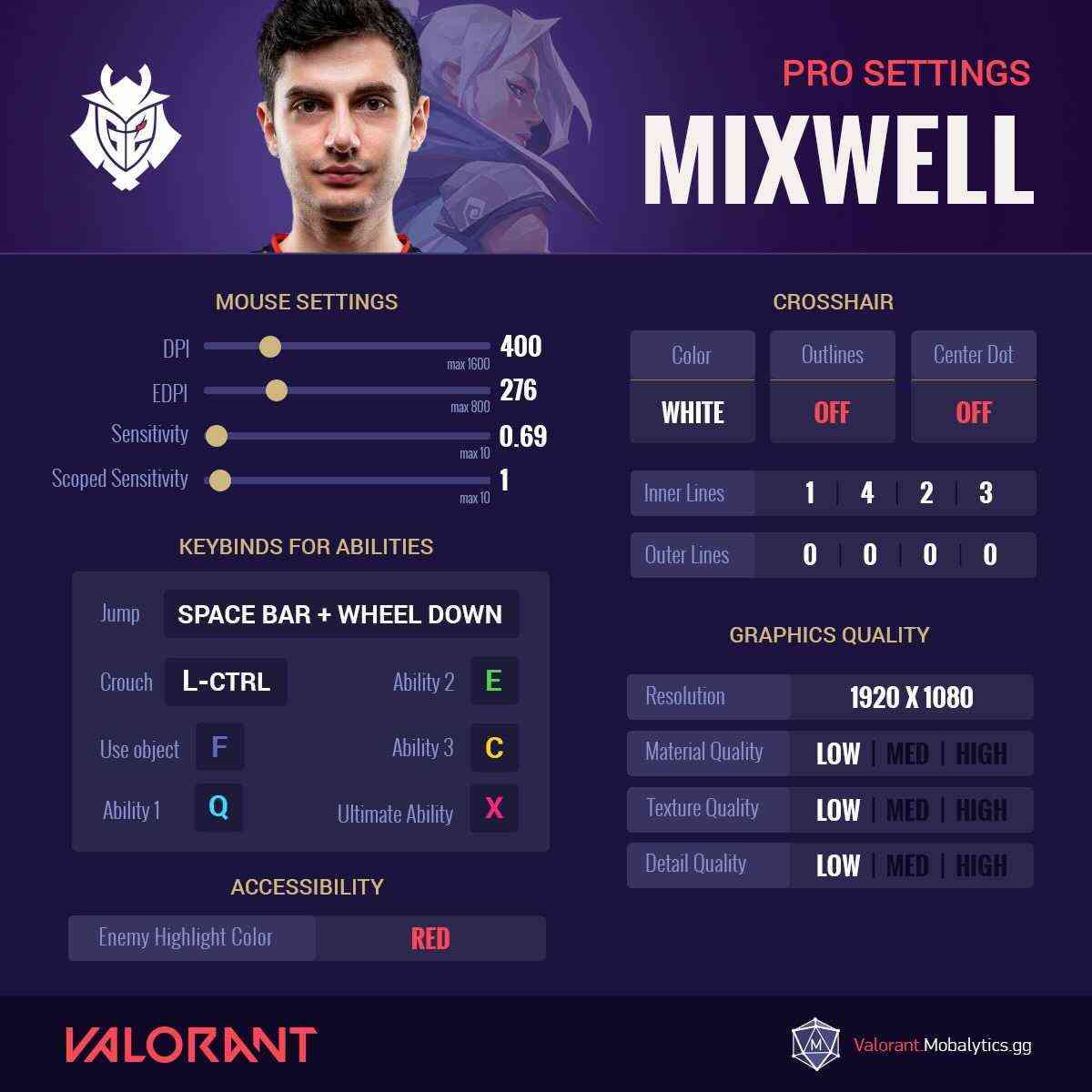
Mixwell settings
Finding the best sensitivity settings for Valorant requires experimentation and adjustment. Start with standard settings and fine-tune them based on your play style and preferences. Remember, something other than what works for one player might work for another. Be patient and persistent in finding your perfect sensitivity. Share your experiences and settings with others to help the community grow. Happy gaming!
What is the best sensitivity to use in Valorant?
What sensitivity do pros use in Valorant?
Professional players in Valorant typically use a wide range of sensitivities, but most prefer lower eDPI (Effective Dots Per Inch) for better precision and control. An API between 200 and 400 is standard. For instance, players like TenZ use an eDPI of around 320, combining 800 DPI with an in-game sensitivity of 0.4. Each player’s preference can vary, but lower eDPI values are generally favored for competitive play.
How do I convert my sensitivity from other games to Valorant?
You can use online conversion tools or formulas to convert your sensitivity from other games to Valorant. A comprehensive guide on converting sensitivities between Valorant and other popular games like CS can be found at Blix.gg.
Is high sensitivity better for aiming in Valorant?
High-sensitivity settings can benefit quick movements and rapid reactions, especially in close-quarters combat. However, they can also make it harder to aim precisely at longer distances. Players and professionals prefer lower-sensitivity settings to maintain better control and accuracy. Ultimately, the best sensitivity setting depends on your preference and play style.
How does mouse DPI affect my gameplay in Valorant?
Mouse DPI (Dots Per Inch) affects how sensitive your mouse is to movement. A higher DPI means the cursor moves further on the screen for each inch you move the mouse. In Valorant, you combine your mouse DPI with your in-game sensitivity to calculate eDPI and measure your overall sensitivity better. A balanced DPI and sensitivity setting can enhance precision and control, improving overall gameplay performance.
Can I use the same sensitivity settings across different games?
While you can use similar sensitivity settings across different games, it’s important to note that each game may interpret sensitivity differently due to factors like engine mechanics and in-game movement speeds. Converting your sensitivity settings using specific formulas or tools can help maintain a consistent feel across games. However, slight adjustments might be necessary to optimize your performance in each game.


